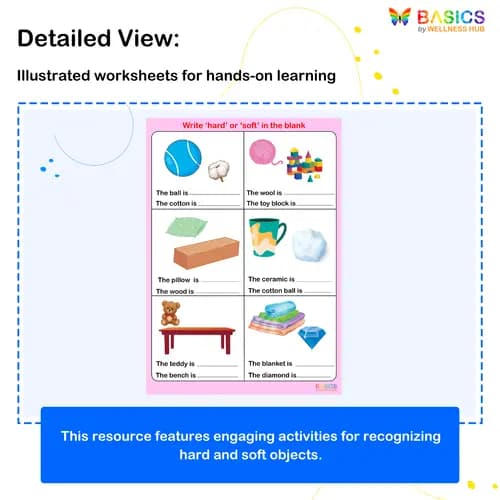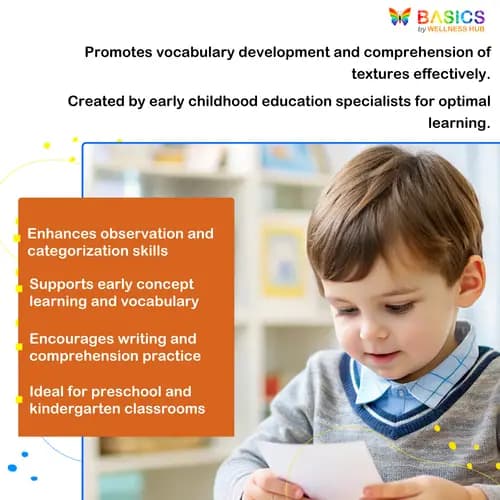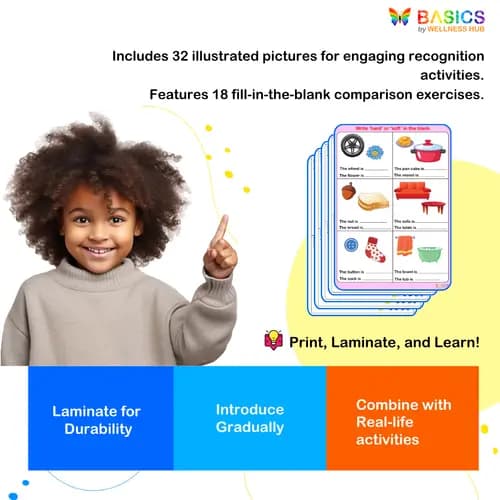




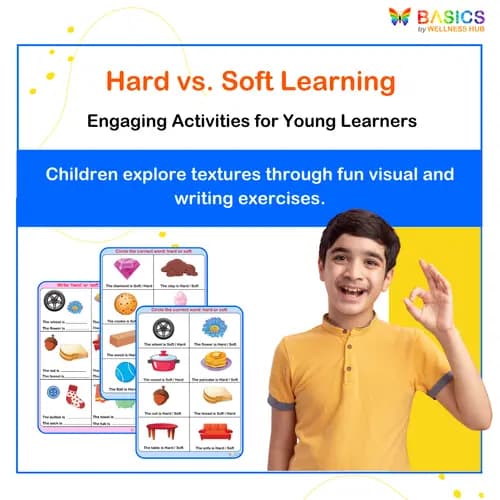
Hard and Soft Objects Worksheets – Printable PDF for Kids
₹80
₹160
50% off
0 (0 ratings)
Grade Levels
Pre-K - Kindergarten (Ages 3-6)
Content Overview
Format: Printable PDF, Total Pages: 7, Features: Engaging activities to learn hard vs soft objects with illustrations.
Categories
Pages from the Resource
This printable PDF helps children understand hard and soft objects through fun visual activities. With 32 illustrated pictures and fill-in-the-blank exercises, kids will learn to identify and describe textures. Perfect for preschool and kindergarten learners to enhance vocabulary, observation, and writing skills.
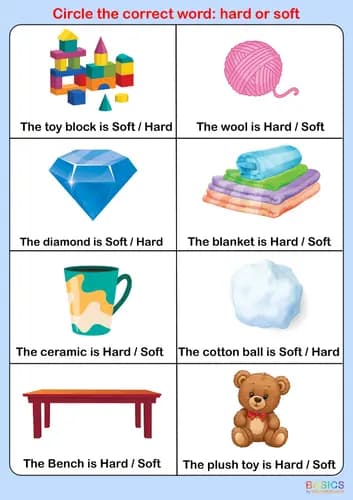
Page 1
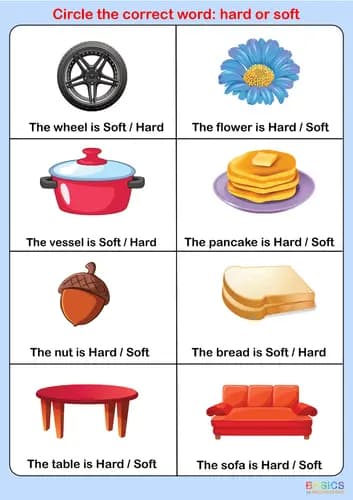
Page 2
What Users Say
0
0 ratings
5
0+
4
0+
3
0+
2
0+
1
0+
5 Stars
Product is Good to use.
1 year ago
Varsha Parent
Similar Products
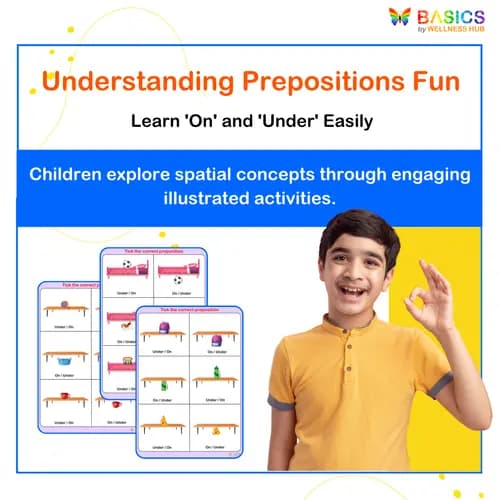
On and Under Prepositions Activity: Printable PDF for Kids
₹ 80.00
₹ 160.00
50% off
4.9 (52 ratings)
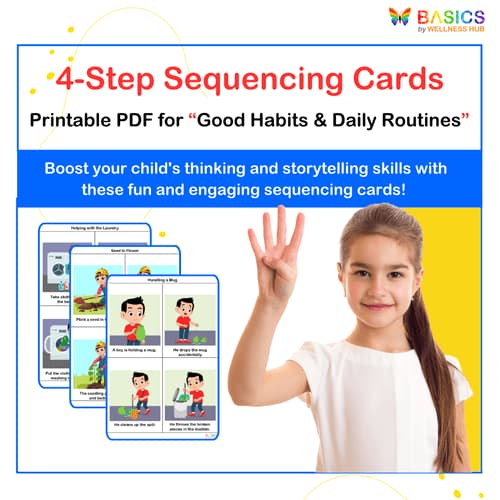
4-Step Sequencing Cards: Printable PDF for Good Habits & Daily Routines
₹ 80.00
₹ 160.00
50% off
4.9 (52 ratings)
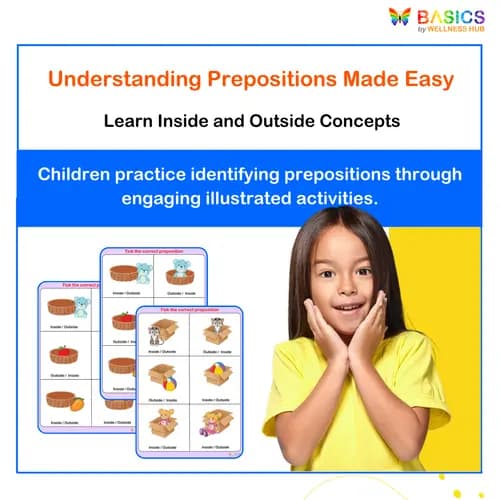
Inside and Outside Prepositions Activity: Printable PDF for Kids
₹ 80.00
₹ 160.00
50% off
4.8 (48 ratings)
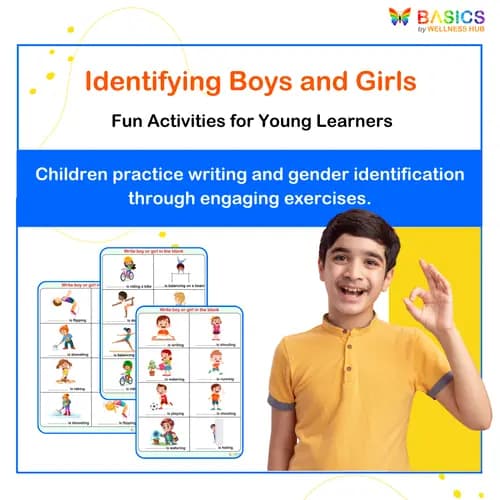
Identifying Boys and Girls: Printable PDF for Observation and Writing
₹ 80.00
₹ 160.00
50% off
4.9 (52 ratings)
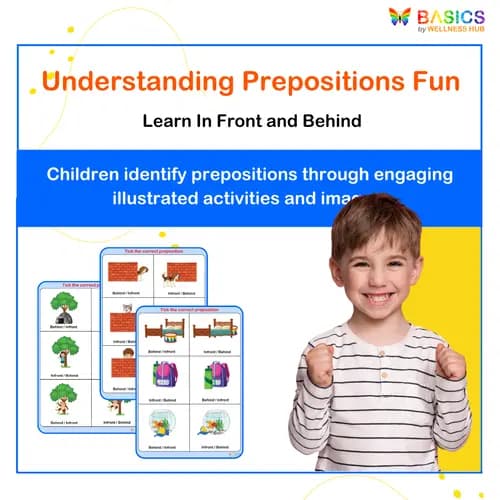
In Front and Behind Prepositions Activity: Printable PDF for Kids
₹ 80.00
₹ 160.00
50% off
4.8 (48 ratings)
About the Product
Introduction
Understanding the difference between hard and soft objects is a fundamental concept for young learners, helping them develop their observational skills and vocabulary. The Hard and Soft Objects Activity PDF is designed for preschool and kindergarten children, providing engaging visual and written activities that make learning about textures both fun and interactive. This resource features a variety of everyday items, allowing children to explore their environment while enhancing their descriptive language skills.
The printable PDF is structured into two parts: the first four pages focus on recognition, where children will circle the correct descriptive word for illustrated objects. The remaining three pages encourage comparison through fill-in-the-blank exercises that reinforce their understanding of hard and soft characteristics. This resource is perfect for use in classrooms, at home, or in therapy settings, promoting early concept learning and fostering a love for language.
Product Details
- Format: Printable PDF
- Total Pages: 7
- Pages 1–4: 8 illustrated pictures per page (32 total) for circle-the-correct-word activity
- Pages 5–7: 6 sets of image pairs per page (18 total) for fill-in-the-blank comparison activity
- Illustrations: Child-friendly images of everyday objects
- Learning Objectives: Vocabulary development, comprehension of texture attributes, observation, categorization, and writing skills
- Designed For: Preschool and kindergarten learners (Ages 3-6)
Activity Breakdown:
Educational Benefits
1. Enhances Vocabulary Development
- Introduces children to descriptive words related to texture, such as "hard" and "soft."
- Encourages the use of new vocabulary in everyday conversations and activities.
2. Strengthens Observation Skills
- Promotes careful examination of images, helping children differentiate between hard and soft objects.
- Encourages critical thinking as they analyze the characteristics of various items.
3. Supports Writing and Comprehension Skills
- Provides fill-in-the-blank activities that enhance writing abilities and sentence structure understanding.
- Helps children practice spelling and using descriptive words in context.
4. Fosters Categorization and Comparison Skills
- Encourages children to categorize objects based on their textures, reinforcing classification skills.
- Promotes understanding of comparisons through paired image activities, enhancing cognitive development.
5. Engages Young Learners
- Utilizes colorful illustrations and interactive activities to maintain children's interest and motivation.
- Makes learning about textures fun and relatable, fostering a positive attitude towards education.
Instructions for Use
Step 1: Print the PDF
- Download and print the Hard and Soft Objects Activity PDF on standard A4 or Letter-sized paper.
- Consider laminating the pages for durability and repeated use in various settings.
Step 2: Introduce the Concept
- Begin by discussing the concepts of hard and soft with the child.
- Show them examples from their environment (e.g., a rock vs. a pillow) to illustrate the differences.
Step 3: Circle-the-Correct-Word Activity
- Start with pages 1–4, where children will circle the correct descriptive word for each illustrated object.
- Encourage them to say the words aloud as they circle to reinforce learning.
Step 4: Discuss Each Item
- After completing the circling activity, review each item together.
- Ask questions like, "Why is the bread soft?" or "What makes the rock hard?" to deepen understanding.
Step 5: Fill-in-the-Blank Comparison Activity
- Move on to pages 5–7, where children will fill in the blanks for paired image sets.
- Guide them to think about the characteristics of each object before writing their answers.
Step 6: Review and Reinforce
- Go over the answers together, discussing why each object is categorized as hard or soft.
- Encourage the child to use their new vocabulary in sentences about their own experiences.
Step 7: Incorporate Real-Life Examples
- Encourage children to find hard and soft objects around the house or classroom.
- Create a scavenger hunt to make it more engaging and interactive.
Step 8: Repeat and Reinforce
- Revisit the activities periodically to reinforce learning and ensure retention of concepts.
- Celebrate their progress and encourage them to share what they've learned with others.
Activities Using the Resource
1. Object Scavenger Hunt
Objective: Reinforce understanding of hard and soft objects through real-world exploration.
How to Play:
- Create a list of hard and soft items for the child to find around the house or classroom.
- As they locate each item, ask them to categorize it as hard or soft and explain their reasoning.
- Encourage them to take pictures or draw the items they find.
Skill Development:
- Observation and categorization skills
- Vocabulary application in context
- Critical thinking
2. Texture Sorting Game
Objective: Enhance categorization skills by sorting various objects.
How to Play:
- Gather a collection of household items (e.g., sponge, rock, blanket).
- Have the child sort them into two groups: hard and soft.
- Discuss why each item belongs in its respective category.
Skill Development:
- Classification abilities
- Descriptive language use
- Decision-making skills
3. Create Your Own Picture Book
Objective: Foster creativity and reinforce vocabulary through storytelling.
How to Play:
- Have the child create a simple picture book using drawings or cut-out images of hard and soft objects.
- Encourage them to write sentences describing each item, using "hard" or "soft" appropriately.
- Share the book with family or friends.
Skill Development:
- Writing and storytelling skills
- Vocabulary development
- Artistic expression
4. Hard and Soft Charades
Objective: Encourage active participation and understanding of textures through movement.
How to Play:
- Take turns acting out hard and soft objects without speaking (e.g., pretending to hold a rock or a pillow).
- Others guess the object based on the actions.
- Discuss why each object is categorized as hard or soft after guessing.
Skill Development:
- Non-verbal communication
- Vocabulary reinforcement
- Social interaction skills
5. Sentence Completion Challenge
Objective: Develop writing skills through fill-in-the-blank exercises.
How to Play:
- Use the fill-in-the-blank sentences from pages 5–7.
- Read each sentence aloud and have the child fill in the blanks with the correct descriptive words.
- Encourage them to create additional sentences using new objects.
Skill Development:
- Sentence structure understanding
- Spelling practice
- Vocabulary expansion
6. Hard vs. Soft Art Project
Objective: Combine art and learning by creating a visual representation of hard and soft objects.
How to Play:
- Provide materials like paper, fabric, and cardboard for the child to create a collage of hard and soft items.
- Label each item with "hard" or "soft" and display the artwork.
- Discuss the characteristics of each item used in the collage.
Skill Development:
- Creative thinking
- Fine motor skills
- Vocabulary application
Frequently Asked Questions
Q1: What age group is this resource designed for?
A1: The Hard and Soft Objects Activity PDF is specifically designed for preschool and kindergarten learners, typically ages 3 to 6. The engaging visuals and simple language make it accessible for young children who are just beginning to explore concepts of texture and descriptive language. This resource is ideal for introducing foundational vocabulary and helping children make observations about the world around them.
Q2: Can this resource be used in therapy settings?
A2: Yes, this resource is highly effective in therapy settings, particularly for speech and language therapy. It supports vocabulary development, comprehension, and writing skills, making it a valuable tool for therapists working with children who need assistance in understanding descriptive language and categorization. The structured activities encourage interaction and engagement, which are crucial for effective learning in therapeutic contexts.
Q3: How can I differentiate activities for children with special needs?
A3: The Hard and Soft Objects Activity PDF can be easily adapted to meet the needs of children with varying abilities. For children who may struggle with writing, you can provide verbal prompts or allow them to use stickers to indicate their answers. Additionally, you can modify the pace of the activities or provide one-on-one support to ensure that each child can participate fully and benefit from the learning experience.
Q4: How do I access customer support if I have questions about the resource?
A4: You can reach our customer support team through the contact form on our website. We are here to help with any questions or concerns you may have about the resource or its usage. Our team typically responds within 24-48 hours to ensure you receive the assistance you need, and we are committed to providing a positive experience for all our customers.
Q5: What is your refund policy if I am not satisfied with the resource?
A5: We strive to ensure that all our customers are satisfied with their purchases. If you are not happy with the Hard and Soft Objects Activity PDF, you can request a refund within 14 days of purchase. Please contact our support team with your order details, and we will assist you promptly. Your satisfaction is important to us, and we want to ensure you have a positive experience with our products.
Q6: How many pages does the Hard and Soft Objects Activity PDF contain?
A6: The Hard and Soft Objects Activity PDF consists of a total of 7 pages. The first four pages feature 32 illustrated pictures of everyday items, where children circle the correct descriptive word, while the remaining three pages include 18 sets of image pairs for a fill-in-the-blank comparison activity. This structure allows for a comprehensive exploration of hard and soft objects through engaging activities.
Q7: What are the licensing and usage rights for this resource?
A7: When you purchase the Hard and Soft Objects Activity PDF, you receive a personal, non-transferable license to use the resource for educational purposes. This means you can print and use the materials in your classroom, therapy sessions, or at home, but you are not permitted to redistribute or sell the resource. We encourage you to share your experience with others, but please direct them to our website for their own copies.
Q8: How will I receive the PDF after purchase?
A8: After completing your purchase, you will receive an email with a download link for the Hard and Soft Objects Activity PDF. The file will be available for immediate download, allowing you to access the resource right away. If you encounter any issues with the download, please reach out to our customer support team for assistance.
Q9: Do you offer bulk or school licensing for this resource?
A9: Yes, we offer bulk licensing options for schools and organizations that wish to purchase multiple copies of the Hard and Soft Objects Activity PDF. This is a great way to ensure that all educators or therapists have access to the resource for their students. For more information on pricing and availability, please contact our support team, and we will be happy to assist you.
Q10: Are your resources accessible for children with different learning needs?
A10: We are committed to creating resources that are inclusive and accessible for all children. The Hard and Soft Objects Activity PDF features clear visuals and straightforward language to support diverse learning styles. Additionally, the activities can be easily modified to accommodate various needs, ensuring that every child has the opportunity to engage with and benefit from the material.
Usage Rights and Restrictions
Allowed Usage:
- Personal use by parents, teachers, and therapists.
- Printable for classroom, home, or therapy settings.
- Can be used in group or one-on-one learning sessions.
Not Allowed:
- Reselling, redistributing, or modifying the resource for commercial use.
- Sharing publicly (e.g., on blogs, social media, or websites) without permission.
- Uploading the file to public sharing platforms.
If you need a bulk license for schools or therapy centers, please contact us.
Conclusion
The Hard and Soft Objects Activity PDF is an exceptional resource for preschool and kindergarten learners, designed to make the exploration of textures engaging and educational. With its combination of visual recognition and comparison exercises, this resource not only enhances vocabulary and comprehension but also fosters critical thinking and observation skills. By using this printable PDF, children will gain a deeper understanding of the world around them, learning to categorize objects based on their physical properties.
Ideal for use in various settings—whether at home, in classrooms, or during therapy sessions—this resource supports diverse learning needs and encourages interactive participation. Equip your child with the foundational skills necessary for effective communication and observation, and watch their confidence grow as they master the concepts of hard and soft objects. Download the Hard and Soft Objects Activity PDF today and inspire a love for learning through hands-on activities!
